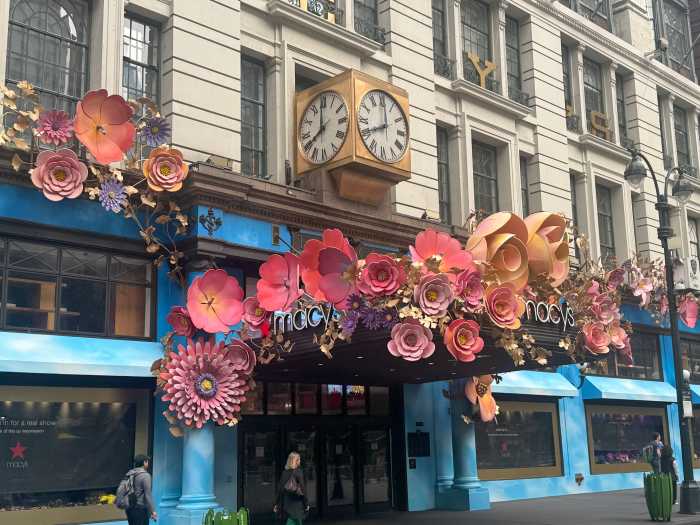-
 Warhol was known for his studio, The Factory, which operated in several locations over the artist’s career.
Warhol was known for his studio, The Factory, which operated in several locations over the artist’s career.
The first location was located on the fifth floor of 231 E. 47th St., in midtown. Warhol noted in his 1975 book “The Philosophy of Andy Warhol” that even early on in his career celebrities like writer Jack Kerouac, poet Alan Ginsberg, actresses Jane Fonda and Judy Garland and the Rolling Stones began to come by The Factory “to peek at the on-going party.”
The studio served as both his home and studio for a time.
“My apartment was on top of Shirley’s Pin-Up Bar, where Mabel Mercer would come to slum and sing ‘You’re So Adorable,'” he wrote. “The building was a five-floor walk-up and originally I’d had the apartment on the fifth floor. Then, when the second floor became available, I took that too, so now I had two floors, but not two consecutive ones. After I got my TV, though, I stayed more and more in the TV floor.”
“The location was great. . . . The Pope rode by on 47th Street once on his way to St. Patrick’s. Khrushchev went by once, too. It was a good, wide street,” Warhol wrote.
In 1968, Warhol moved his studio to the sixth floor of the Decker Building at 33 Union Square West, where it remained until 1973. It was at this location that he was shot on June 3, 1968 by Valerie Solanas, who, according to a New York Daily News article from the time, told the arresting officer, “The police are looking for me. I am a flower child. He had too much control over my life,” as she handed him the gun used in the shooting.
After 1973, the studio moved to 860 Broadway. From 1984 until his death, The Factory resided in a townhouse at 22 E. 33rd St. According to a 1992 article in New York magazine, Warhol’s name was signed to his finished works by employees, who then packed the paintings up to move them to storage.
In this photo: Warhol during an interview in his 33 Union Square West Factory on May 16, 1969; and, a current view of the building’s exterior.” data-id=”112122679″ data-link=”https://amnewyork.wpengine.com/wp-content/uploads/2019/10/7992_image.jpg” class=”wp-image-1.12122679″/>
Photo Credit: Newsday / Bill Senft; Google Maps -
 Julia Warhola lived with her son for nearly two decades. In 1957, the two collaborated on an illustrated book, “Holy Cats.” Warhol made a 66-minute film, “Mrs. Warhol,” in 1966 in her basement apartment, featuring his mother as the lead actress.
Julia Warhola lived with her son for nearly two decades. In 1957, the two collaborated on an illustrated book, “Holy Cats.” Warhol made a 66-minute film, “Mrs. Warhol,” in 1966 in her basement apartment, featuring his mother as the lead actress.In this photo: Warhola is comforted leaving Columbus Hospital in Manhattan on June 3, 1968, after Warhol had been shot earlier in the day.
” data-id=”112119616″ data-link=”https://amnewyork.wpengine.com/wp-content/uploads/2019/10/7993_image.jpg” class=”wp-image-1.12119616″/>
Photo Credit: Newsday / Stan Wolfson -
 Warhol designed a poster for the Brooklyn Bridge centennial celebration in 1983 by screen-printing an image of the bridge onto a board. Though the work is not on display, the Brooklyn Museum holds it in storage.
Warhol designed a poster for the Brooklyn Bridge centennial celebration in 1983 by screen-printing an image of the bridge onto a board. Though the work is not on display, the Brooklyn Museum holds it in storage.
In this photo: On April 5, 1983, the late Mayor Edward Koch introduces the poster during a news conference, while Warhol, who frequently carried a camera, snapped a photo of him.
” data-id=”112110288″ data-link=”https://amnewyork.wpengine.com/wp-content/uploads/2019/10/7841_image.jpg” class=”wp-image-1.12110288″/>
Photo Credit: Newsday / Dan Goodrich -
 According to Thomas Kiedrowski’s book “Andy Warhol’s New York City: Four Walks, Uptown to Downtown,” Warhol lived in a townhouse at 57 E. 66th St. during his final years, moving in around 1974. According to a 2011 New York Post piece, Kiedrowski said, “He would go antiquing every day . . . He didn’t use the stuff, he would just put it in boxes. When a Sotheby’s auction came up after his death, they said everything was in their boxes . . . [Warhol] had never opened any of it. But he was so excited when he found out he could write [the purchases] off on taxes as a business expense for Andy Warhol Enterprises.”
According to Thomas Kiedrowski’s book “Andy Warhol’s New York City: Four Walks, Uptown to Downtown,” Warhol lived in a townhouse at 57 E. 66th St. during his final years, moving in around 1974. According to a 2011 New York Post piece, Kiedrowski said, “He would go antiquing every day . . . He didn’t use the stuff, he would just put it in boxes. When a Sotheby’s auction came up after his death, they said everything was in their boxes . . . [Warhol] had never opened any of it. But he was so excited when he found out he could write [the purchases] off on taxes as a business expense for Andy Warhol Enterprises.”
According to a 2012 Curbed article, executors of Warhol’s estate found a trap door in the master bedroom, women’s jewelry tucked into the four-poster bed, green boxes of wings and a medicine cabinet full of makeup tubes and perfume bottles.
In 2000, then-MTV president Tom Freston purchased the 12-room home for $6.5 million, putting it back on the market for $35 million in 2008.
In this photo: This is the exterior of Warhol’s townhouse on March 3, 1988, just over a year after his death.
” data-id=”112119733″ data-link=”https://amnewyork.wpengine.com/wp-content/uploads/2019/10/14344_image.jpg” class=”wp-image-1.12119733″/>
Photo Credit: Newsday / Ari Mintz
Andy Warhol, illustrator, filmmaker and a leader of the pop art movement, was born on Aug. 6, 1928, as Andrew Warhola. (He later dropped the final a). Though originally from Pittsburgh, Pennsylvania, Warhol moved to New York City in 1949 after finishing his degree at the Carnegie Institute of Technology, now, Carnegie Mellon University.
With 2018 marking what would have been Warhol’s 90th birthday, the Whitney Museum of Art is celebrating with a four-month exhibition dedicated to the artist, kicking off this November. Tickets for “Andy Warhol-From A to B and Back Again,” $25 each, are now on sale.
In his 1975 book, “The Philosophy of Andy Warhol,” the artist discussed his initial encounter with NYC.
“When I was eighteen a friend stuffed me into a Kroger’s shopping bag and took me to New York. I still wanted to be close to people. I kept living with roommates thinking we could become good friends and share problems, but I’d always find out that they were just interested in another person sharing the rent. At one point, I lived with 17 different people in a basement apartment on 103rd Street and Manhattan Avenue, and not one person out of the 17 ever shared a real problem with me,” Warhol wrote.
From the Chelsea Hotel to his Factories, Serendipity 3 and Max’s Kansas City, he made New York City his home. Here are some of the places where Warhol made his mark, before he died on Feb. 22, 1987.

































